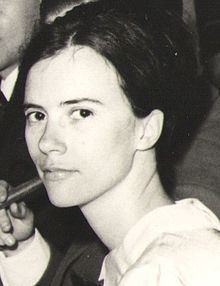Daisy Roulland-Dussoix (1936 -2014) molecular microbiologist, was one of the discoverers of restriction enzymes during her doctoral studies, for which a Nobel prize was awarded to Werner Arber.
Daisy Roulland-Dussoix (née Daisy Dussoix) gained her first degree in Chemistry and Biology from University of Geneva (1958), followed by her doctorate in Biophysics (1964).
She worked for her PhD with Werner Arber and Eduard Kellenberg, Swiss microbial geneticists, at the time when the barriers to infection of bacterial cells by virus (bacteriophage) first became apparent, leading to the discovery of restriction and modification enzymes that have subsequently became essential molecular biology tools. These enzymes result in cleavage of DNA by enzymes at sites characterised by specific sequences unless these are protected by prior enzymatic modification to the DNA bases. This system protects bacterial cells from viral infection. The research of Grete Kellenberger-Gujer had already demonstrated that phage DNA could be degraded by host bacterial cells. Daisy Dussoix and Werner Arber showed that this process required enzymes, resulting in two publications that paved the way for discovery and isolation of the restriction and modification enzymes involved. They had previously presented these results at the First International Biophysics Congress in Stockholm in 1961.
In 1964 Dussoix moved to Stanford University, USA, funded by a Jane Coffin Childs postdoctoral fellowship to work with Robert Lehman. She subsequently worked as Assistant Professor in Residence in the Department of Microbiology from 1968 at the University of California, San Francisco and continued to study DNA restriction and modification with Herbert W Boyer. She later worked with the research group of Harold E. Varmus on understanding how avian src protoncogenes worked. She subsequently moved to the University of California, Berkeley.
In early 1980 Dussoix-Roulland returned to Europe and worked at the Institut Pasteur in Paris on detection of mycoplasmas using PCR-based molecular methods. She was appointed Group Head of the Mycoplasma Laboratory in 1987 in the Viral Oncology Unit of Luc Montagnier. Her publications from these years focused on mycobacterium and mycoplasmas, specifically genetic and molecular characterization and the development of detection methods.
Contributions and controversy over Nobel Prizes
Dussoix-Roulland was a member of the research groups of two future Nobel Prizewinners (Werner Arber (for discovery of restriction enzymes), and the group of Harold Varmus and J. Michael Bishop (for the cellular origin of retroviral oncogenes). Her contribution to these discoveries, and whether she should have had greater recognition, has been a topic of controversy.
In 1964 she married Daniel Roulland, chef at The Star in San Francisco. In 1996 she contracted malaria and as a consequence suffered from long-term neurological problems. Following the death of her husband, she returned to Geneva in 2006, where she died in 2014.
Cultrera, R.; Roulland-Dussoix, D.; Romanit, R.; Contini, C. (1998). "Use of PCR to detect mycoplasma DNA in respiratory tract specimens from adult HIV-positive patients". Journal of Medical Microbiology vol. 47 (11): 983–986. doi:10.1099/00222615-47-11-983. Rawadi, G.; Dujeancourt-Henry, A.; Lemercier, B.; Roulland-Dussoix, D. (1998). "Note: Phylogenetic position of rare human mycoplasmas, Mycoplasma faucium, M. buccale, M. primatum and M. spermatophilum, based on 16S rRNA gene sequences". International Journal of Systematic Bacteriology. 48 (1): 305–309. doi:10.1099/00207713-48-1-305. Rawadi, G.; Lemercler, B.; Roulland-Dussoix, D. (1995). "Application of an arbitrarily-primed polymerase chain reaction to mycoplasma identification and typing within the Mycoplasma mycoides cluster". Journal of Applied Microbiology. 78 (6): 586–592. doi:10.1111/j.1365-2672.1995.tb03103.x. Rawadi, G.; Jean-Louis Lalanne, J-L.; Roulland-Dussoix, D. (1995). "Cloning and characterization of the lipase operon from Mycoplasma mycoides subspecies mycoides LC". Gene. 158 (1): 107–111. doi:10.1016/0378-1119(95)00160-8. Roulland-Dussoix, D.; Henry, A.; Lemercier, B. (1994). "Detection of mycoplasmas in cell cultures by PCR: a one year study". Journal of Microbiological Methods. 19 (2): 127–134. doi:10.1016/0167-7012(94)90044-2. Dussurget, O.; Roulland-Dussoix, D. (1994). "Rapid, sensitive PCR-based detection of mycoplasmas in simulated samples of animal sera". Appl Environ Microbiol. 60: 953–959. Lazraq, R.; Clavel-Seres, S.; David, H.L.; Roulland-Dussoix, D. (1990). "Conjugative transfer of a shuttle plasmid from Escherichia coli to Mycobacterium smegmatis [corrected]". FEMS Microbiol. Lett. 57: 135–138. Labidi, A.; David, H.L.; Roulland-Dussoix, D. (1985). "Restriction endonuclease mapping and cloning of Mycobacterium fortuitum var. fortuitum plasmid pAL5000". Ann Inst Pasteur Microbiol. 136B (2): 209–215. PMID 3002238. Spector, D.H.; et al. "Uninfected avian cells contain RNA related to the transforming gene of avian sarcoma viruses". Cell. 13: 371–379. doi:10.1016/0092-8674(78)90205-2. CS1 maint: Explicit use of et al. (link)Bulkacz, J.; Roulland-Dussoix, D.; Boyer, H.W. (1975). "Deoxyribonucleic acid modification by intermediate-type modification mutants of Escherichia coli K-12 and B". J Bacteriol. 124: 1395–1402. Yoshimori, R.; Roulland-Dussoix, D.; Boyer, H.W. (1972). "R factor-controlled restriction and modification of deoxyribonucleic acid: restriction mutants". J Bacteriol. 112: 1275–1279. Boyer, H.; Scibienski, E.; Slocum, H.; Roulland-Dussoix, D. (1971). "The in vitro restriction of the replicative form of W.T. and mutant fd phage DNA". Virology. 46: 703–710. doi:10.1016/0042-6822(71)90072-9. Roulland-Dussoix, D.; Boyer, H.W. (1969). "The Escherichia coli restriction endonuclease B". Biochim. Biophys. Acta. 195: 219–229. doi:10.1016/0005-2787(69)90618-2. Boyer, H.W; Roulland-Dussoix, D. (1969). "A complementation analysis of the restriction and modification of DNA in Escherichia coli". J. Mol. Biol. 41: 459–472. doi:10.1016/0022-2836(69)90288-5. Roulland-Dussoix, D (1967). "Degradation by the host cell of DNA of bacteriophage lambda irradiated by ultraviolet rays". Mutation Research. 4: 241–252. doi:10.1016/0027-5107(67)90019-x. Dussoix, D.; Arber, W. (1965). "Host specificity of DNA produced by Escherichia coli. IV. Host specificity of infectious DNA from bacteriophage lambda". J. Mol. Biol. 11: 238–246. doi:10.1016/s0022-2836(65)80054-7. Dussoix, D.; Arber, W. (1962). "Host specificity of DNA produced by Escherichia coli. II. Control over acceptance of DNA from infecting phage lambda". J. Mol. Biol. 5: 37–49. Arber, W.; Dussoix, D. (1962). "Host specificity of DNA produced by Escherichia coli. I. Host controlled modification of bacteriophage lambda". J. Mol. Biol. 5: 18–36. 
